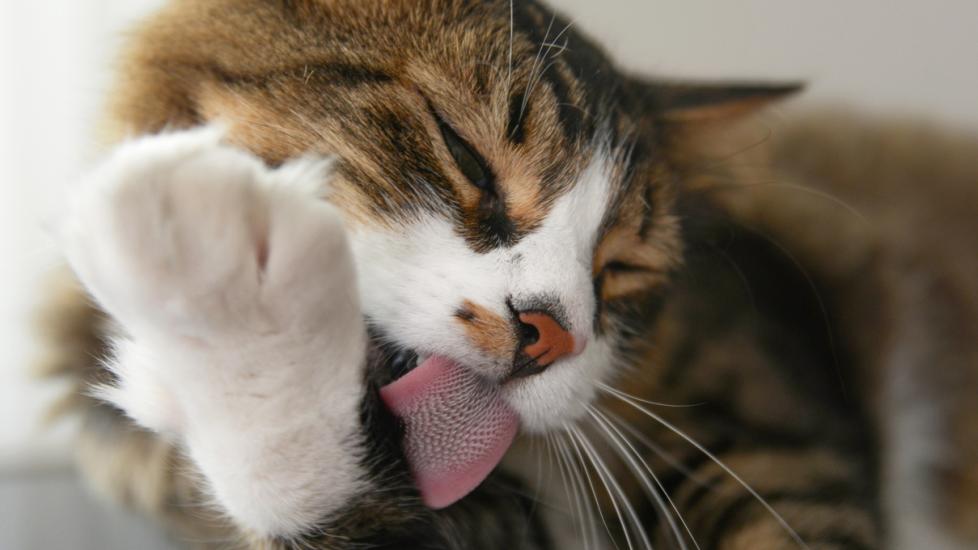5 Facts About Cat Tongues
You may have been licked by your cat only to be surprised to discover that the tongue is quite different from a dog’s tongue. Instead of being soft and wet, it’s dry and bristly. There are quite a few reasons for that, related to cats’ natural lifestyle. Read on to find out why your cat has such a unique structure hidden inside her mouth.
Key Takeaways
- Cats have hundreds of hook-like papillae covering the entire tongue, which make it feel like sandpaper.
- When cats groom they are improving circulation under the skin, helping to regulate temperature, and distributing natural conditioning oils to keep fur healthy and shiny.
- If you notice your cat is drooling, contact a veterinarian immediately.
The Power of Papillae
The rough texture comes from the tiny, white, keratin protein spines that cover the surface of the tongue called papillae. Keratin is the same material that makes up kitty claws—and your own fingernails. You can see these rough projections when you’re able to catch a glimpse of the tongue when your cat yawns or grooms herself. There are hundreds of hook-like papillae covering the entire tongue, which make it feel like sandpaper, and provide valuable functions for the cat.
Papillae serve as a “rasp” when they are eating their prey, helping to scrape small amounts of meat off the bones and move it towards the back of the mouth. Through this, cats can get as much food as possible off the bone, making it practical during times of scarcity. Although most cats may not be required to absorb every calorie from her bowl of canned food, wild lions and tigers benefit from this adaptation.
Papillae serve as a “rasp” when they are eating their prey, helping to scrape small amounts of meat off the bones and move it towards the back of the mouth.
The Ultimate Brush
These papillae also aid in grooming since these hooks act like a comb to separate and run through the fur. This lifts dust, debris, loose hair, and dry skin off the cat’s coat, all of which can irritate the skin and lead to health problems.
The act of grooming also improves circulation under the skin, helps regulate temperature, and distributes natural conditioning oils to keep the fur shiny and healthy. The papillae function is to transfer saliva to the part of the hair closest to the skin. So, the cat is essentially grooming herself from the surface out, which is important to keep the skin healthy.
Unfortunately, the tongue is partly responsible for hairballs because the backward-facing spines bring the hair back into the throat, where it is swallowed and later vomited back out. Consistent brushing by pet parents can help remove the loose hair before it gets trapped by the papillae.
The Slurp Function
Cats have a unique way to transfer water from its source to their bellies. They can curl part of their tongue to be shaped like a tiny bowl, and then scoop up water using the very tip of the tongue, which is covered in papillae. When this tiny bowl is full (usually from five or six laps of water), the cat will swallow.
This is similar to sucking water up a straw, and the process starts all over again after each gulp of water. You can likely watch your own cat do this while drinking out of a faucet or a glass bowl at counter height.
Even more fascinating is that cats can move the papillae on their tongue. When papillae are not needed, they lay flat against the tongue, but when it’s time to put them to use the cat can stand them upright through a muscular reflex, so they are ready to go to work!
The Taste Palate
Cats are known to be finicky eaters, but the reality is that their sense of taste is different than that of a human. Cats are obligate carnivores, meaning that the diet that provides them the most nutrition is made up exclusively of meat.
Their 473 taste buds (versus the 9,000 taste buds of humans and 1,700 tastebuds of dogs) can identify the same tastes sensed by people. This includes tastes such as sweet, salty, bitter, umami, and sour.
Their 473 taste buds (versus the 9,000 taste buds of humans and 1,700 tastebuds of dogs) can identify the same tastes sensed by people. This includes tastes such as sweet, salty, bitter, umami, and sour. But cats have a reduced sense of sweet, tend to gravitate toward the savory senses, and dislike sour foods. Cats also can identify another taste that people cannot—ATP which is associated with meat. This means they enjoy their meat more than their human companions.
Signs of When to Call a Veterinarian
The tongue is also a window into the world of your cat’s health. Normally, the tongue should be pink and relatively dry. If you notice that your cat is drooling, this should prompt an immediate call to your veterinarian. Additionally, if you see that the tongue is inflamed, pale, blue, yellow, swollen, or has any type of sore on it, notify your veterinarian immediately.
Most cats keep their tongues primarily in their mouths, although they will sometimes “forget” to pull it in after eating or grooming—a cute trait that is also considered normal. However, if your cat is suddenly leaving its tongue out for long periods more frequently or panting and showing the tongue more, contact your veterinarian for guidance.
Cat tongues are remarkable and unique structures well designed to suit their needs. Additionally, you can snap some iconic photos of your cat lapping up water or catch some glamour shots while they are grooming.
Featured Image: iStock.com/Burak Can Oztas
